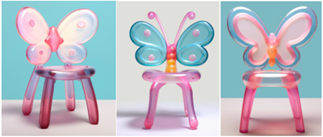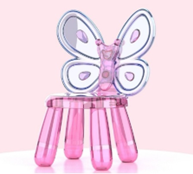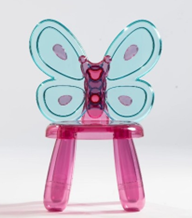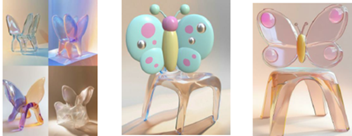Xiaoquan (Claus) Zhang, 28 May 2025, first published by IAM
On 19 March 2025, the Zhangjiagang Court of Jiangsu Province handed down a decision dismissing a copyright infringement and unfair competition suit that designer Feng Runjuan brought against manufacturer Kuashi Plastic, distributor DongShan Culture, a natural person Aisha Zhu and others concerning a children’s chair with a butterfly shaped back.
Feng filed an appeal before the Suzhou Intermediate Court to challenge the dismissal, but the court interpreted her failure to pay the appeal fees as withdrawal, thus rendering the first-instance decision final.
Case background
Feng cited three AI-generated images (Figure 1), which she allegedly created using the Midjourney platform by entering the prompt: "Children's chair with jelly texture, shape of cute pink butterfly, glass texture, light background". She shared both the prompt and resulting images on RedNote, a Chinese social media app, on 15 August 2023.

Figure 1. Feng's AI-generated images
Five days later, Feng was approached by Aisha Zhu on behalf of the accused companies, who offered to commercialise and mass produce Feng’s design.
After the negotiation failed, Zhu used Feng’s publicly shared prompt to generate similar designs, made some tweaks and proceeded to manufacture and sell chairs featuring the below design (Figures 2 and 3) in January 2024.

Figure 2. The accused design

Figure 3. The accused design
In June 2024, Feng brought a suit against the defendants before the Zhangjiagang Court, requesting cessation and destruction of the inventory and mould, as well as damages of 200,000 yuan.
Court decision
The dispute ultimately boiled down to whether the AI-generated images qualify as original works that are eligible for copyright protection.
To support her claim, Feng attempted to recreate the images of Figure 1 using almost identical prompts – but to no avail. She acknowledged that the randomness and the inherently unpredictable nature of AI-generated outputs made her unable to reproduce the exact same images.

Figure 4. The recreated images
The court observed that the recreated versions differed significantly from the originals and concluded that this divergence demonstrated a lack of substantiated author-driven expressions. The court elaborated on the parameters in assessing the copyrightability of AI-generated content. It held that a user must provide a verifiable creative process that shows the:
- adjustment, selection and embellishment of the original images by adding prompts and changing parameters; and
- deliberate, individualised choices and substantial intellectual input over the visual expression elements, such as layout, proportion, perspective, arrangement, colour and lines.
As Feng failed to meet this threshold, the court ruled that the initial images did not qualify as original works eligible for copyright protection.
Clarification on AI-generated content protection threshold
This is the first Chinese court decision that explicitly denies copyright protection to content predominantly generated by AI without substantial human input. Rather than categorically denying the copyrightability of AI-generated content, the decision draws a line between AI-generated and AI-assisted content.
The court used the level of human input as a litmus test to assess the originality of AI-generated content. Content that is autonomously created by AI does not qualify as a "work" under copyright law. Conversely, content generated by users employing AI tools and contributing original and creative input may still qualify for protection. This practice aligns with the methodology introduced in the 2025 US Copyright Office report “Copyright and Artificial Intelligence, Part 2: Copyrightability”, which underscores the need to evaluate the human role in AI-generated works.
Key takeaways
This ruling highlights a fundamental principle – copyright law protects human creativity, not machine output. Humans should dominate the creation process, not the other way around. Putting AI in the driver’s seat is like putting the cart before the horse. Creators using AI tools should ensure that their creative process is properly documented and could be reproduced, particularly the specific contributions that they made to the final work.
It is also worth noting that the court reaffirmed the distinction between ideas and expression. It found that prompts fall within the realm of ideas, which are not eligible for copyright protection. This is a welcome decision as the free use of publicly shared prompts is conducive to promoting openness and collaboration in this space.